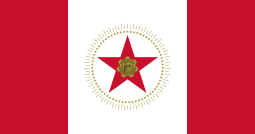
The flag of Minnesota is the state flag of Minnesota. Its design features a modified version of the seal of Minnesota on a blue field. The first version of the flag was flown from 1893 until 1957, and was changed to be more easily manufacturable, and the state seal became simpler. The current flag was adopted in 1957 and the state seal on the flag was modified in 1983. The flag has been criticized as racist and white supremacist, depicting a white settler displacing a Native American without historical context provided about violence against Native peoples. As of March 24th, 2022, a new task force has been created by the Minnesota Legislature to discuss possibilities for flag modification and replacement.

The flag of the U.S. state of New Mexico consists of a red sun symbol of the Zia people on a field of gold (yellow), and was officially introduced in 1925. It was designed in 1920, to highlight the state's Native American Pueblo and Nuevo México Hispano roots. The symbology is designed to represent the Puebloans and the colors of the flag of Spain.

The Flag of Tennessee consists of an emblem on a field of red, with a strip of blue bordered by white on the fly. The emblem in the middle consists of three stars on a blue circle also with a white border. The central emblem portion of the flag has been adopted as the state's unofficial logo, and appears in the logos of some Tennessee-based companies and sports teams. Examples include the First Horizon Bank and the Tennessee Titans.

The seal of the president of the Philippines is a symbol used to represent the history and dignity of the president of the Philippines. Its original form was designed by Captain Galo B. Ocampo, secretary of the Philippine Heraldry Committee, and patterned after the seal of the president of the United States. It was first used by President Manuel Roxas in 1947.

The flag of Indianapolis has a dark blue field with a white five-pointed star pointing upwards in the center. Around the star is a circular field in red. Surrounding the red field is a white ring, from which extend four white stripes from top to bottom and from hoist to fly, thus creating four equal quadrants in the field. The stripes are about one-seventh the width of the flag, with the white ring the same width as the stripes. The diameter of the red circle is about two-ninths the width of the flag.

The city flag of Los Angeles consists of a background of three notched stripes of green, gold and red. The flag was designed by Roy E. Silent and E.S. Jones in 1931 for the Los Angeles sesquicentennial from 1781.

The flag of Nashville, Tennessee, consists of the city's seal on a white disc surrounded by a field of blue, with a strip of gold on the fly. According to the resolution adopting the flag, the blue stands for the courage and conviction of the city's leaders throughout history, while the gold denotes the richness of city's land and resources. The flag was adopted in December 1963 when the governments of Nashville and Davidson County merged to form the Metro government. In an official ceremony, it was reigned in as the new flag on August 4, 1964, at the Metropolitan Courthouse. The flag is modeled after the Tennessee state flag.

The flag of Denver is the official flag of the City and County of Denver in Colorado. It was designed by a North High School student, Margaret Overbeck, and adopted in 1926. A zigzag white stripe horizontally separates a red field below from a blue field above, in which is centered a yellow circle, together forming a stylized depiction of the Sun in a blue sky above snow-capped mountains. The color yellow symbolizes gold in the state's hills, and red the colored earth to which the word colorado refers. The circle's centered position symbolizes Denver's central location within the state. The white zigzag symbolizes Colorado's Native American heritage.

The municipal flag of Buffalo is the official banner of the city of Buffalo, New York. The navy blue flag contains a large central emblem consisting of the city seal with 13 "electric flashes" and interspaced 5-pointed white stars emanating from it.

The flag of St. Louis, Missouri, consists of a solid red background and three thick, wavy lines colored blue and white extending from the top left corner, bottom left corner, and center right edge. Upon the intersection of these lines there is a yellow disk containing a blue fleur-de-lis. The flag was designed by Yale University professor Theodore Sizer and officially adopted in 1964.

The Seal of the Vice President of the Philippines is a symbol used to represent the history and dignity of the vice president of the Philippines. Its design was prescribed by Executive Order No. 310 of 2004, and is similar in design to the Seal of the President of the Philippines.

The flag of Phoenix, Arizona, is the official municipal flag of Phoenix, Arizona. Its current design is simply a maroon field with a white phoenix emblem in the center. The design is the second in the city's history and has been in place since 1990, replacing a flag that was adopted in 1921.

The official flag of Mobile is a flag which represents the seal of the six flags that have flown over the state of Alabama before and since it became a state. The flag was adopted in December 1968 after one was suggested by Commissioner Lambert C. Mims. The original seal which was used in the flag was adopted in 1961.

The flag of Tulsa consists of an upper navy blue half and a lower beige half, separated by a gold horizontal line, with a gold Osage shield punctuating the left third. The shield contains a red circle, and a beige six-pointed star centered within the circle. The flag is notable for being one of the few modern flags to utilize beige in its design - a color often associated with faded dyes on flags from usage.

The flag of San Antonio is the official municipal flag of San Antonio, Texas. The sketch of the flag's design, drawn by Spanish–American War veteran William W. Herring, was dated May 28, 1933. The design saw significantly more usage than the official flag, but was never officially adopted until 1976. The current flag is a slightly modified version of Herring's design, most notably removing the text formerly displayed.

The flag of San Jose is the official municipal flag of San Jose, California. The current design, a triband of gold on top, white in the middle, and blue on the bottom with the city's official seal in the center, has been the official flag since 1984.

The flag of Austin is the official municipal flag of Austin, Texas. The flag simply consists of a white field with the seal of Austin without the surrounding circle of text. Below the seal of Austin is the text, "CITY OF AUSTIN", written in blue and arched upwards.

The flag of Charlotte is the official municipal flag of Charlotte, North Carolina. The official flag was adopted in 1929 and consists of a white saltire on a blue field, with the city seal in the center. A secondary flag, with a green field and a white crown in the center, was introduced in 1985 and is used at city government buildings. The latter flag is able to be seen in public at certain spots around Charlotte, whereas the former one is not. Charlotte is one of the few places to have two official flags with equal status.

The flag of Columbus is the official municipal flag of Columbus, Ohio. Its current design is a yellow, white, red vertical triband with the city seal on a blue field. Officially, the flag was adopted in 1929, although it is unknown if the flag was ever flown when it was first adopted.

The flag of El Paso is the official municipal flag of El Paso, Texas. The current design, an augmentation of El Paso's seal in the center of a dark blue field, has been in place since 1962.




















